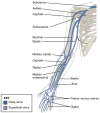Perils of the PICC: Peripherally Inserted Central Catheter-Associated Complications and Recommendations for Prevention in Clinical Practice-A Narrative Review
- PMID: 40868612
- PMCID: PMC12385984
- DOI: 10.3390/healthcare13161993
Perils of the PICC: Peripherally Inserted Central Catheter-Associated Complications and Recommendations for Prevention in Clinical Practice-A Narrative Review
Abstract
Background: Peripherally inserted central catheters (PICCs) are becoming an increasingly utilised alternative to traditional central venous access devices. Their uptake, particularly among oncology patients, is due to their growing ease of access, suitability for medium-term use and perceived safety profile. However, PICCs can be a source of severe and life-threatening complications such as central line-associated bloodstream infection (CLABSI), deep vein thrombosis (DVT), pulmonary embolism (PE), malpositioning, dislodgement, and occlusion.
Methods: This narrative was constructed from a literature review of the PubMed database, utilising MESH terms for peripherally inserted central catheters, percutaneous central catheters, PICC, and complications. Randomised controlled trials, systematic reviews, and meta-analyses published between 2015 and 2025 were included. Additional articles were obtained through targeted PubMed searches or from references within previous articles.
Results: Major periprocedural complications were seen in 1.1% of PICC insertions, CLABSI in 1.4-1.9%, venous thrombosis embolism (including PE) in 2.3-5.9%, and malpositioning in 7.87%. The overall PICC complication incidence was 9.5-38.6%, which is greater than that of centrally inserted central venous access. A higher BMI, diabetes mellitus, chronic renal failure, and malignancy were the most significant predictive factors for PICC-associated complications.
Conclusions: PICC complications are common, occurring more frequently than other forms of central venous access, and may lead to significant morbidity and mortality. Appropriate assessment of patient risk factors and optimisation strategies may reduce complication rates.
Keywords: anaesthesia; central line-associated bloodstream infection; complication; critical care; incidence; intensive care; peripherally inserted central catheters; prevention; review; thrombosis.
Conflict of interest statement
The authors declare no conflicts of interest.
Figures
Similar articles
-
Peripherally inserted central catheter design and material for reducing catheter failure and complications.Cochrane Database Syst Rev. 2024 Jun 28;6(6):CD013366. doi: 10.1002/14651858.CD013366.pub2. Cochrane Database Syst Rev. 2024. PMID: 38940297 Free PMC article.
-
Prescription of Controlled Substances: Benefits and Risks.2025 Jul 6. In: StatPearls [Internet]. Treasure Island (FL): StatPearls Publishing; 2025 Jan–. 2025 Jul 6. In: StatPearls [Internet]. Treasure Island (FL): StatPearls Publishing; 2025 Jan–. PMID: 30726003 Free Books & Documents.
-
Continuous heparin infusion to prevent thrombosis and catheter occlusion in neonates with peripherally placed percutaneous central venous catheters.Cochrane Database Syst Rev. 2005 Jul 20;(3):CD002772. doi: 10.1002/14651858.CD002772.pub2. Cochrane Database Syst Rev. 2005. Update in: Cochrane Database Syst Rev. 2008 Apr 16;(2):CD002772. doi: 10.1002/14651858.CD002772.pub3. PMID: 16034876 Updated.
-
The risk of bloodstream infection associated with peripherally inserted central catheters compared with central venous catheters in adults: a systematic review and meta-analysis.Infect Control Hosp Epidemiol. 2013 Sep;34(9):908-18. doi: 10.1086/671737. Epub 2013 Jul 26. Infect Control Hosp Epidemiol. 2013. PMID: 23917904
-
Risk of venous thromboembolism associated with peripherally inserted central catheters: a systematic review and meta-analysis.Lancet. 2013 Jul 27;382(9889):311-25. doi: 10.1016/S0140-6736(13)60592-9. Epub 2013 May 20. Lancet. 2013. PMID: 23697825
References
-
- Kolikof J., Peterson K., Williams C., Baker A.M. StatPearls. StatPearls Publishing; Treasure Island, FL, USA: 2025. Central Venous Catheter Insertion. - PubMed
Publication types
LinkOut - more resources
Full Text Sources


